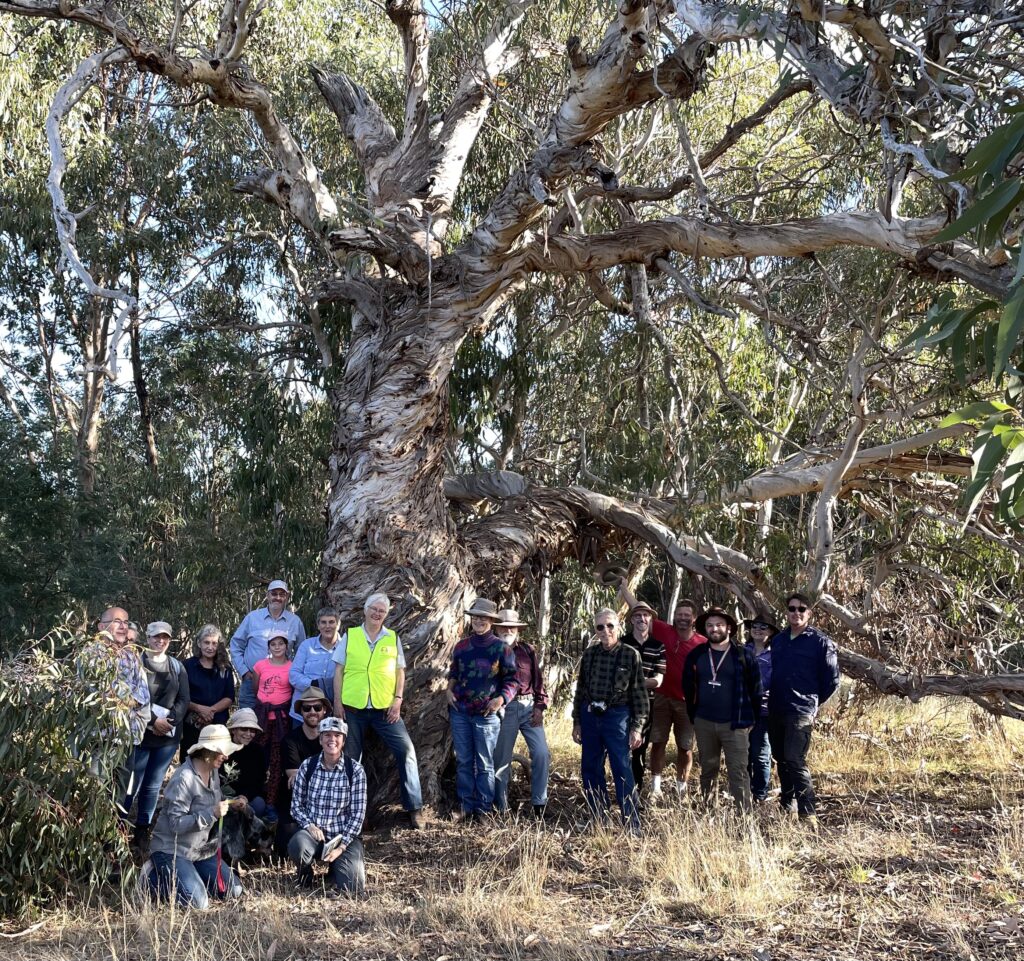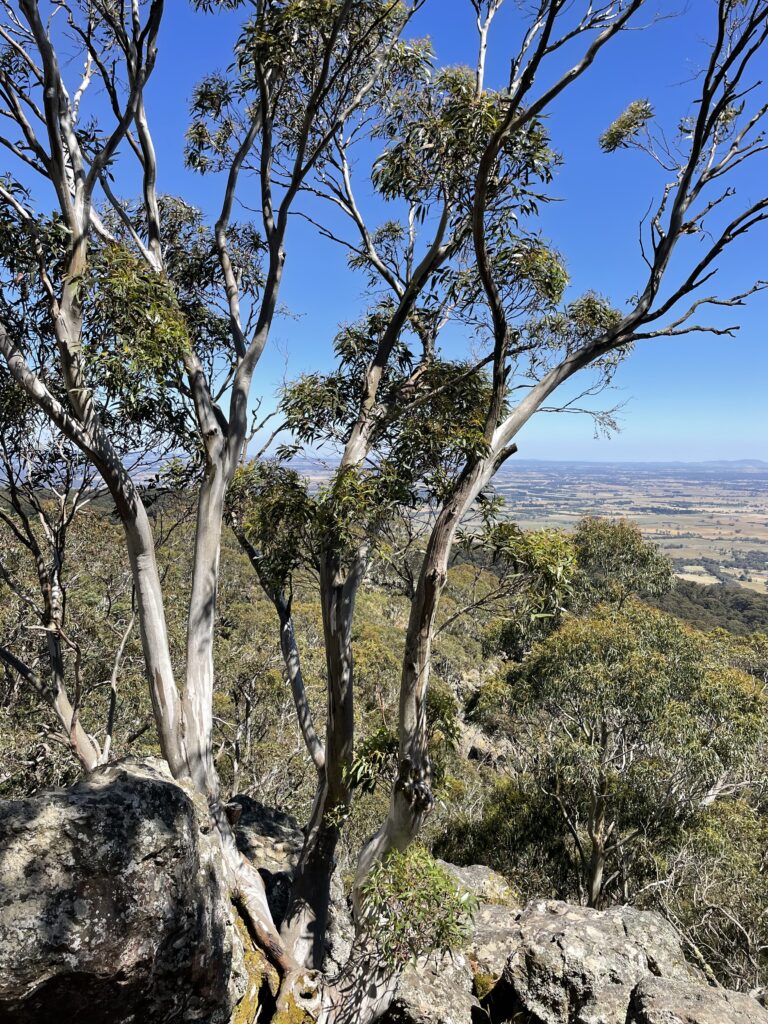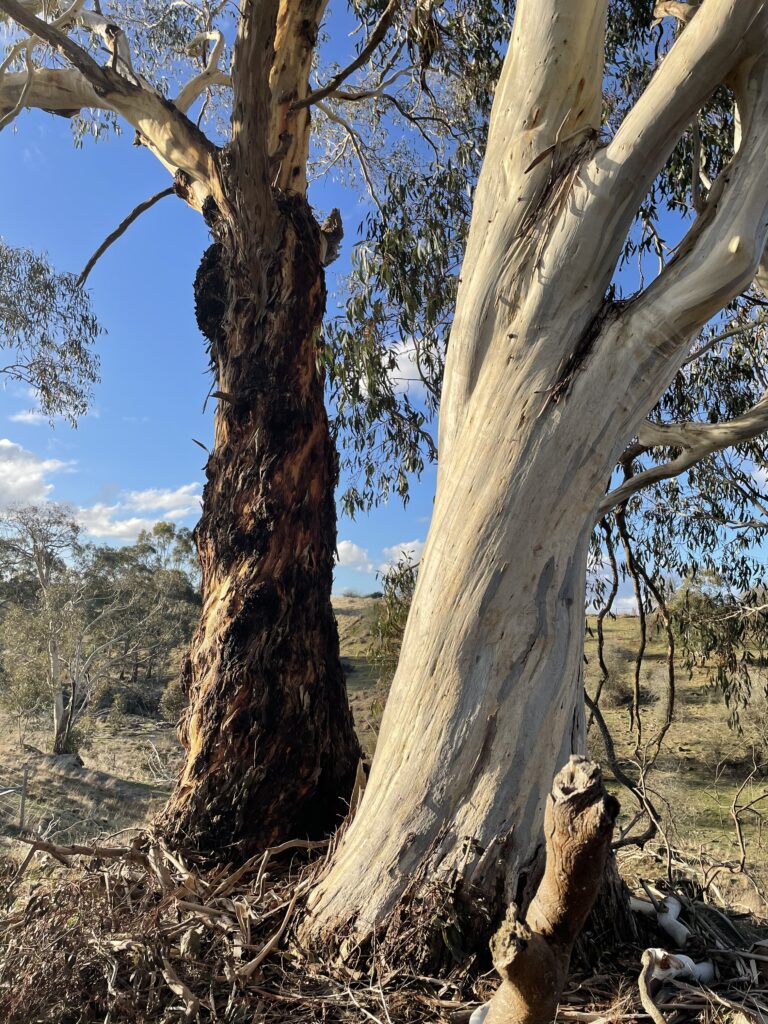The first time I really ‘met’ a Snow Gum was not in classic Snow Gum habitat; on top of a mountain in the high country. This Snow Gum was by the Campaspe River, on a private property in Ashbourne, west of Woodend. The landholders had done a capital job of restoring their river frontage, and their exemplary paddock management meant that their large old trees would survive for generations to come.
And what large old trees they were! Massive Manna Gums with long limbs snaking along the ground, Yarra Gums with healthy dense canopies, towering Candlebarks and – the highlight – many wonderful old Snow Gums. Snow Gums have stunning white, grey and multi-coloured bark that is especially beautiful when wet. Lowland Snow Gums which grow below 800m altitude are quite different in form to the Snow Gums we may observe growing in the Victorian Alps, or at the summit of Mount Macedon. These Campaspe River snow gums were huge and heavy trunked, much like a Manna Gum. Unlike the mallee-like form of the higher altitude Snow Gums which are twisted and multi-stemmed as the trees cope with the hazards of harsh mountain living.
The landholder showed me how to identify the Snow Gums from the other white gums such as Candlebarks. Snow Gum fruits or gum nuts are very large and the leaves are also quite distinct, with parallel veins rather than a network of veins branching out from a central line.
Fast forward a year or so later to 2022, and I began working at Macedon Ranges Shire Council as their Biodiversity Projects Officer. I was delighted because one of my first roles involved taking the reins of a council led Snow Gum Citizen Science Project!

Citizen scientists and Snow Gum fans at a HUGE specimen on a private property in Newham.
The birth of the project began back in 2018, when the development of the Macedon Ranges Shire Council Biodiversity Strategy revealed some community concern about the dieback occurring in the Snow Gum population on Mount Macedon. The species was also selected as a target species for monitoring ecosystem health, as climate modelling indicates this vegetation type is the most vulnerable to climate change.
Meanwhile, Newham and District Landcare Group, and in particular member Helen Scott, fell completely in love with the Snow Gums growing along their roadsides and in their paddocks and a number of beautiful photo essays and studies were published in their local newsletter. Seed was collected, and young Snow Gums propagated and handed out to new members.
Macedon Ranges Snow Gum Project
Given the increasing signs of climate change, and the community concern and passion for Snow Gums, Council’s environment team applied for and were successful in obtaining funding through the Victorian Government’s ADAPT Loddon Mallee Program for a year-long community project centred on this species.
The project managed to achieve much from May 2021 to June 2022! Firstly, a local Snow Gum working group was formed. This group included representatives from Macedon Ranges Shire Council, Arthur Rylah Institute, Parks Victoria, Newham and District Landcare Group, Baynton-Sidonia Landcare Group and Ashbourne Landcare Group.
The working group engaged local ecological consultants Karl Just and Tim D’Ombrain to assess the distribution and health of Snow Gum (Eucalyptus pauciflora ssp. pauciflora) populations across the Macedon Ranges. Their brief was to collect spatial, quantitative and qualitative data to better inform local programs for the ongoing protection and management of the species across the region.
As much of Macedon Ranges Shire is on private land by necessity the project had a strong citizen science focus. Building on the excellent education work of Newham Landcare, Council launched a Snow Gum monitoring blitz – with a brochure, eNews articles and social media asking residents to send in their Snow Gum sightings.
In partnership with Newham Landcare and the Macedon Ranges Field Naturalists, Council staff led a Eucalypt Identification workshop. This very pleasant afternoon involved the ins and outs of eucalypt identification, the ecology of eucalypts and the flora and fauna that depend upon them, and the care of these large woodland giants on private land. The workshop concluded at a much loved Snow Gum affectionately known as ‘the whopper’.
Meanwhile, ecologists Karl and Tim undertook detailed assessments of the distribution and health of Snow Gums across the shire, traversing the roadsides and visiting landholders who had submitted sightings. Nothing like a visit from an ecologist on your property!
What is so special about Snow Gums?
Snow Gums are one of approximately 700 species of Eucalypts described in Australia. They came a cool second in the vote for Australia’s Favourite Tree in 2022, losing out to the iconic and much loved River Red Gum. Snow Gums are revered for their beauty, their tenacity and will to survive even the harshest snowy environments.
They have a wide distribution, ranging from eastern South Australia, across central and southern Victoria, central and eastern Tasmania, eastern New South Wales, extending north across the New England Tablelands plateau to near the Queensland border. Although they are most well known for their alpine populations, there are scattered lowland populations, with some Snow Gums in SW Victoria and Gippsland growing at 50 metres above sea level!
Unfortunately many alpine populations are suffering from dieback, caused in part by a beetle whose wood-boring larvae are killing the trees as the climate warms. Climate modelling also paints a picture of a species under threat – as this thirsty species requires at least 600 millimetres annual rainfall to thrive.

Snow Gums from Camels Hump, Mount Macedon / Geboor
While not listed in Australia, the Snow Gum qualifies as Near Threatened in the IUCN Red List of Threatened Species.
Project results
In June 2022, the project report was published, titled Assessment of the Distribution, Health and Ecology of Snow Gum (Eucalyptus pauciflora ssp. pauciflora) populations in the Macedon Ranges Shire. Lead ecologist Karl presented the project findings at a public meeting in June. This gathering of Snow Gum enthusiasts from across the Macedon Ranges even featured a local harpist playing a composition inspired by the much-loved species!
Despite still bearing the scars from the 1983 Ash Wednesday fires, the Mount Macedon Snow Gum population was assessed as being in relatively good health, with over 50% of trees assessed as in ‘very good’ health. In the lowland populations the picture as even more positive with 77% of trees recorded as ‘very good’.
Happily, the health assessment also found that there are plenty of young Snow Gums in the region. This means the local conditions are still suitable for recruitment, and that adequate numbers of saplings are reaching maturity.
But what got all of us really excited is that the assessment identifies the Macedon Ranges population of both alpine and low-lying snow gums as significant: the report concludes that Macedon Ranges Shire has the ‘largest number of individuals and sub-populations of Snow Gum known to occur outside of the Alps region”.
Newham Landcare’s Snow Gums, with some 697 trees distributed across 5 hectares, was identified as the largest lowland population in Victoria!
The enthusiastic participation in the Snow Gum Citizen Science project revealed a cohort of Snow Gum Guardians already taking action to protect and nurture this wonderful eucalypt. From a Macedon Ranges Shire Council perspective, we feel that the Snow Gum can now be promoted as a mark of pride and point of difference for our shire and its residents.
Outside Macedon Regional Park, the majority of the Snow Gums recorded were on Council owned roadsides highlighting that Council has a special responsibility for the care of the species. Although Snow Gum health was assessed as generally good, and recruitment levels are also steady; we very much look forward to working with Landcare groups, landholders and agencies such as Parks Victoria, all of whom have a vital part to play in the ongoing protection and survival of Snow Gums in Victoria, particularly as the climate warms and dries.

Two Snow Gums side by side in Ashbourne – showing how different the bark can be! Both trees had leaves with parallel veins and large gum nuts.
This article was first published in the March 2023 edition of the VNPA Park Watch magazine https://vnpa.org.au/macedon-ranges-majestic-snow-gums/
0 Comments